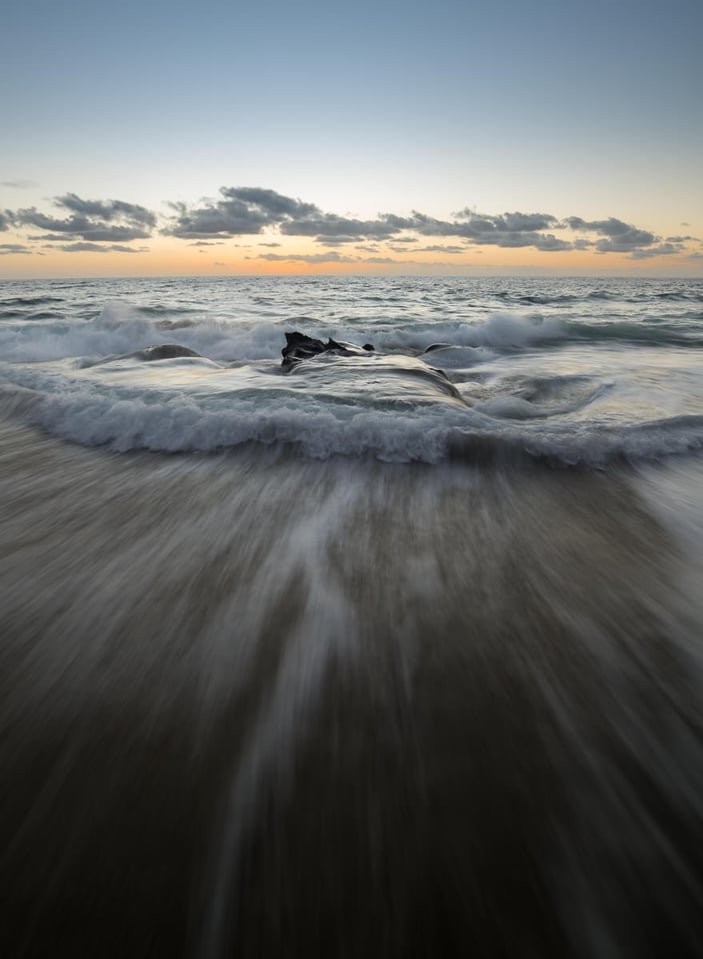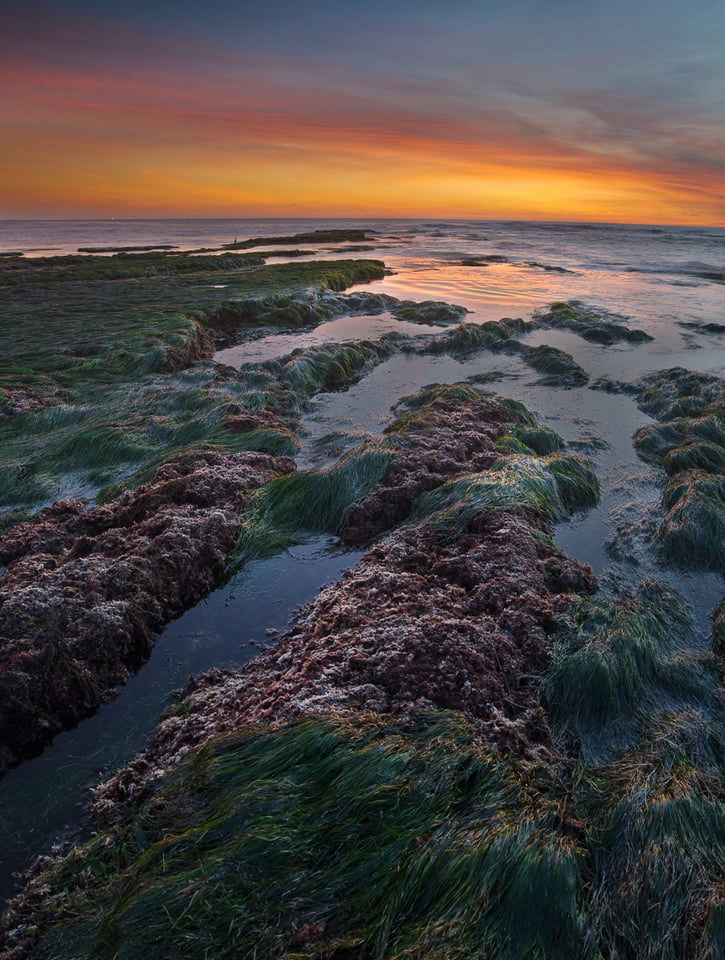I have a confession: I have a love/hate relationship with seascapes. Sometimes I feel like they are easy, monotonous and a little bit of a sham — an easy way to impress others without having to put in the requisite amount of work. On such days I vow never to shoot a seascape again. And then there are moments when I cannot resist the pull of the ocean. When the sky looks like it will go up in flames at sunset casting it’s glow on everything the light touches — the sand, the rocks, the water. When the tide is high and the waves crashing violently into the surf promise dramatic foregrounds. ‘This will be my greatest seascape,’ I tell myself as I pick up my gear and head for the beach, bracing for the challenge ahead.
By now the reader has probably picked up on the contradiction. How can something be easy and boring and challenging and exciting at the same time? I would argue that it can be.
Truth is that the seascapes do simplify the most critical aspect of photography — the composition. A typical ocean-front vista is so inherently interesting and appealing and the shapes of the constituent elements (shoreline, rocks, sand, waves) so undefined that the photographer has tremendous freedom and opportunity with how to frame the shot.
The photo above taken on a day when the sunset had complete fizzled out. The thick clouds had flattened the dynamic range and so all I had to do was point-and-shoot to capture this image. I returned home disappointed but out of curiosity, posted this image on social media to see how it would be received. To my surprise it garnered far more accolades than images that I believed were far more creative and challenging to execute.
At the same time, the most interesting seascapes often involve getting up close and personal with those nemeses of cameras and lenses: water & sand.

Soon after I took this picture, a rogue wave came, swept right past me and my gear, slamming into the rocks behind me leaving me drenched on the rebound.
While depth-of-field is a challenge for all types of landscape photography, it is especially difficult in seascapes. So much of what’s in the frame is in motion, making techniques like focus stacking impossible and forcing the photographer to get it right on the spot.



More often than not, a very promising sunset will fizzle out, forcing the photographer to get creative in other ways, using wave motion and light to create interest.

Pier shots are quite often a safe choice, with the pier providing a convenient, frame-filling foreground for the dramatic sky. It is not wholly without challenges however, as most compositions have a significant portion of the pier covering the background making it difficult to use graduated filters to address reduce contrast. Also, in my experience, piers offer limited composition opportunities.


Quite often seascapes involve slowing down the shutter speed to create that silky water motion, thereby requiring the use of tripods. It is not quite that easy though, because conditions are often windy and the tripod will need to be placed in moving water for the most interesting compositions. Therefore, the tripod needs to be stable as well as durable (salt water and sand are not kind to tripods).



A low tide is not all bad. When the water recedes, it reveals a diverse, alien landscape below that can make for some interesting photography.

Sometimes, all the stars align perfectly and I manage to make the kind of capture that is going to motivate me to keep going back for more.

At the end of the day — photography or not photography — sunsets at the beach are one of nature’s most remarkable spectacles and I realize what a privilege it is to be able to partake on a regular basis — something for which I will be eternally grateful.

great photos. thanks
Wonderful article and inspirational photos.
I have recently spent as much time wandering the shore line. I too am fascinated by this genre. However, I can attest to your comment about the the sea and sand being enemies of camera and lens; having just had to pay £1000 (sterling) for repairs to my Nikon 750 and 70-200 lens after I misjudged a rogue wave. I was without the equipment for 3 months!
So I might go in search of drier subject matter!
Thanks Jeremy. If it’s any consolation, we’ve all been there … my advice would be to not be discouraged, just be more careful ..
Great shots Tahla, especially like the inclusion of the piers going into the water, very nice. I share your thoughts about seascapes, on one hand you have the perfect components for the ultimate in composition, big ocean and big sky. On the other hand the images captured never seem as dynamic as they did when you saw them first hand, perhaps the landscape painters spoiled the genre for us, I much prefer painted seascapes as opposed to seascape photos. I live on the coast of British Columbia and here are a few ways I have found to make seascapes a little more interesting. The colour, light and intensity has to be present in equal measure for both the sky and the sea. A dynamic sky on top of a flat grey sea or vice versa just doesn’t cut it. I am also not a fan of blurring the waves, I use a faster shutter speed that freezes the waves mid action and seems to give them just a little more character. I also stay away from wide angle and focus on a portion of the scene that contains the most amount of interest to me. I also like to get above the ocean to capture the reflection of the light across the water so if there is a bluff or cliff above the sea I try to get on top so I can look down on the ocean instead of across it, standing on a log or rock can also work. I had to learn not to fear the sun and instead of waiting till the sun drops below the horizon take on the bright light, glare and reflection off the water head on by positioning the sun out of the frame and using a f-16 to f-20 aperture along with -.7 EC and a 200mm-300mm zoom to get that good compression factor going for you. Doesn’t always work but when it does you’ll know it. Lastly, minimal editing, so many photographers ruin their seascapes with too much colour saturation, up here in northern latitudes the ocean just doesn’t get that blue. And if you can come across a pier, well so much the better.
Michael, this kind of feedback is exactly why posting on PL is far more helpful than at other places where it’s all about the ‘likes’ (not that that’s bad). Thank you. I’ve been thinking about different perspective and will definitely give the top down approach you suggested, a try. And I’m with you on saturation, I don’t like to touch it in general (for landscapes) and particularly for seascapes. But that’s because my camera is pretty capable of capturing color intensity. My problems in that area are mostly related to white balance ..
Beautiful images. Great article.
Thanks Doug.
Really enjoyable images. Thanks for sharing! I feel a connection with your divided mind on this subject. I think the reality is that it is extremely challenging to create a powerful image of something mundane. Photographers are constantly seeking awe-inspiring subjects because even a poorly executed photograph of a powerful subject is better than a masterful image of something boring (in my opinion). On the other hand, you executed these images very well which only adds to them.
I’m with you Matt: composition > execution.
Tahla, good idea!
Beautiful and inspiring work. Thank you Talha for sharing. Thanks to Photography Life and Nasim to publish works by aspiring young photographers like Talha.
It will be interesting to know the location of these seascapes? Were these images significantly altered in post processing and/or HDR?
Thanks Narendra.
All of the seascapes are from the San Diego coast, mostly from La Jolla.
Since my UWA lens can’t take filters, all high dynamic range shots (such as sunsets) require post processing to faithfully reproduce what the eyes saw.
I don’t do HDR but will do manual exposure and focus blending on multiple exposures when necessary. Some times, after the sun has set, I can get away with exposing-to-the-right on capture and adjusting in post.
The truth is that I really haven’t been able to do much seascapes in the past couple of years and so most of the images are from my early photography days when my technique was not quite solid and so I’ve had to compensate to a certain extent in post.
Nice set Talha… only have one little niggle, and it’s a tough one to fix. With an UWA lens it’s always tough to keep the horizon straight when it is placed off center for composition purposes… but that’s just me! I still enjoyed your work immensely!
Cheers and good light,
David
www.flickr.com/photo…ments2013/
Thanks David!
You’re right, UWA poses quite a few challenges. Plus, mine is a manual focus that produces heavy distortion and can’t take any filters.
I would like to try with a 24mm focal length, waiting for the day I can afford the new Nikon 24-70mm …
This excellent portfolio brings me to a subjective artistic judgement with which I am toying before a trip to Iceland with ample opportunity for seascapes and waterfalls.
When the principal subject is a stationary object (or objects) surrounded by moving water, a long exposure to blur water directs attention to the subject. Examples are rocks and icebergs surrounded by turbulence, or a sky over turbulent water.
However when the principal subject is the water itself, such as a waterfall up close, then a fast shutter to capture the fine detail of the water may better convey what I see and feel.
What do others think?
Hi Richard,
Trip to Iceland sounds pretty amazing. Most shots of waterfalls from the region that I’ve seen have the water blurred. So to do the opposite would at least be different. Why not capture both (fast & slow) if possible and pick whatever works best later?
The only example I can think of where I actually focused on the water is this:
www.flickr.com/photo…ed-public/
Anyway, hope you have a great trip, do come back and point us to the results when they’re ready ..
Talha
These are stunning – thanks for posting them!
Thanks Faith!